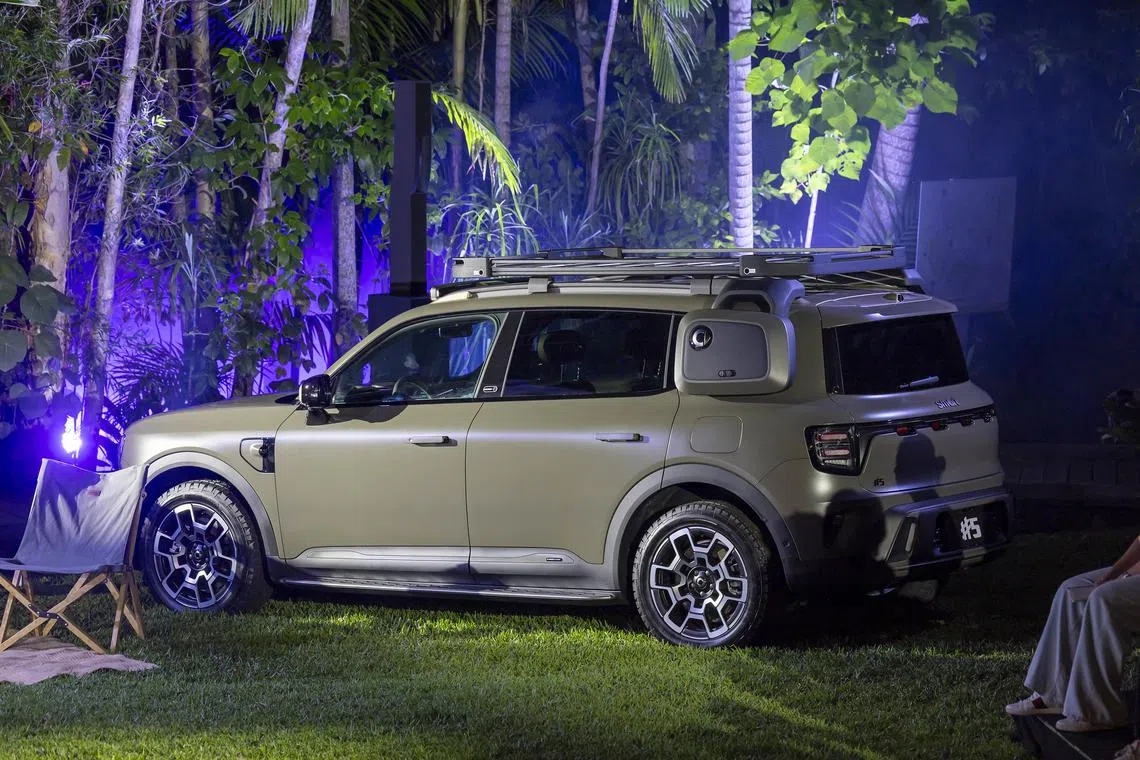With a bed and cinema, Smart’s #5 is a bet on something big
The brand’s new model relies on size, clever features and some Mercedes magic
Webservice User &
Leow Ju-Len
[BYRON BAY] Between the movie projector built into its bumper and the air mattress for two in the cabin, a fellow could have a mighty fine time spending a night in the great outdoors with a Smart #5. Once a Mercedes-Benz division known for making micro urban cars, the brand is going big and beyond city roads with its newest model.
The German-Chinese tie-up (Zhejiang Geely bought half the business from Mercedes) and pure electric brand held the global unveiling of the #5 (pronounced “hashtag five”) at a media event on Aug 28 in Byron Bay, just south of Gold Coast in Australia, a new market for Smart.
A boxy sport utility vehicle (SUV), the #5 is Smart’s largest car by far. Its rugged looks are a departure from the soft curves of the brand’s current cars, while an extra rugged Summit Edition is designed to be a camping enthusiast’s dream. It rides on off-road tyres and has accessories such as a large roof rack and foldable ladder, along with playful touches such as a detachable Bluetooth speaker.
The #5’s squarish shape is a pure expression of what a car for the outdoors should look like, according to Kai Sieber, head of design Smart, at Mercedes-Benz Design. “When we do an urban vehicle, it needs to be more friendly, a little bit soft. But since we’re now doing an outdoors car, it’s honest and square,” he tells the media at the Australia launch.
At just over 4.7 metres long, the #5 is bigger than the Mini Countryman, a car from another brand that left its small urban runabout roots behind. But a long wheelbase of 2.9 metres means it offers three times the kneeroom for rear passengers that some competitors do, says Smart.
Smart claims the #5’s 100-kilowatt-hour battery gives it 740 kilometres of range under China’s testing protocol, equivalent to more than 500 kilometres of real-world range elsewhere. Its 800-volt system (double the voltage of most electric cars) lets it charge from 10 per cent to 80 per cent in just 15 minutes.
Despite its chunky styling, the #5 is also something of a hot rod. Data from China’s Ministry of Transport reveals that four variants will enter the market, with the most powerful one offering 638 horsepower from two motors. Even the least powerful, single-motor rear-wheel drive version has 335 horsepower, roughly the same as how much a 3.0-litre turbo petrol engine would deliver.

That speediness mirrors Smart’s eagerness to accelerate its sales. In the last two years the brand has shipped about 100,000 cars, mainly to customers in China and Germany, the countries it considers its home markets.
But that volume makes Smart a micro player in the Geely empire; the group’s 11 brands (among them famous names such as Lotus, Polestar and Volvo) sold nearly 1.5 million vehicles in the first six months of the year.
SEE ALSO
That could be problematic if Geely intends to follow its recent playbook and take Smart public. It listed Volvo Cars, Polestar Automotive and Lotus Technology over the last three years. Yet, a slowdown in the growth of electric car sales and a high interest rate environment have weighed heavily on those brands’ market value. All are trading well below their initial public offering prices.
That presumably gives Geely reason to bide its time until conditions improve. Meanwhile, Mandy Zhang, Smart’s chief marketing officer, told The Business Times that the brand has a two-pronged plan to grow sales: enter new countries and new product segments.
The #5 is aimed at the family SUV market, for example, and should not only broaden the brand’s appeal but also give existing customers something to upgrade to. “I would say we are on track for our business plan, and also our product portfolio strategy,” she said.
What could elevate Smart from the ranks of so many Chinese electric car companies is the German half of its parentage. While Sieber oversees Smart design, he’s adamant that the brand’s styling department isn’t a corporate backwater. He and his team also work on Mercedes models (the B-Class is one example), and his direct boss is Gorden Wagener, the big kahuna of styling at Mercedes.
“He has a lot of passion for Smart. There are very intense discussions between me, my team and Gorden,” Sieber said. “Some of the Smart designs even influence Mercedes-Benz, because we’ve done some things that he liked very much.” Apparently, the soft, rounded nose of the #1 and #3 was a particular hit with Wagener.
Nevertheless, Sieber isn’t trying to pass the #5 off as an ersatz Benz. “A Mercedes needs to have a Mercedes face and a Smart needs to have a Smart face. So we really work to keep it apart,” he said. “Imagine Smart and Mercedes from a design perspective as one family. The father is Gorden, the mother is me.” That may be so, but it’s Smart’s corporate parents who have big dreams for their big new baby.
Decoding Asia newsletter: your guide to navigating Asia in a new global order. Sign up here to get Decoding Asia newsletter. Delivered to your inbox. Free.
Copyright SPH Media. All rights reserved.

